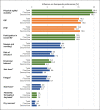Patient Preferences: Results of a German Adaptive Choice-Based Conjoint Analysis (Market Research Study Sponsored by Eli Lilly and Company) in Patients on Palliative Treatment for Advanced Breast Cancer
- PMID: 34720809
- PMCID: PMC8543321
- DOI: 10.1159/000513139
Patient Preferences: Results of a German Adaptive Choice-Based Conjoint Analysis (Market Research Study Sponsored by Eli Lilly and Company) in Patients on Palliative Treatment for Advanced Breast Cancer
Abstract
Introduction: Integration of patient preferences into shared decision making improves disease-related outcomes, but such data from patients with advanced breast cancer (aBC) are limited. The objective of this study was to demonstrate the relative importance of overall survival (OS) and progression-free survival (PFS) in relation to quality of life (QoL) and therapy-associated side effects from the perspective of patients with aBC.
Methods: Postmenopausal patients with hormone receptor-positive, human epidermal growth factor receptor 2-negative aBC receiving first- or second-line treatment were recruited throughout Germany. Patient-relevant attributes for aBC therapy assessment were collected using a stepwise multimodal approach. A conjoint matrix was developed, resulting in 2 attributes for therapy goals (OS and PFS), 4 for QoL, and 6 for side effects. An online quantitative survey was then performed using adaptive choice-based conjoint (ACBC) methodology.
Results: The quantitative survey included 104 patients: 67 (64.4%) receiving first-line treatment and 37 (35.6%) receiving second-line treatment. The QoL attribute "physical agility and mobility" received the highest utility score (19.4 of 100%), reflecting the greatest importance to patients, followed by treatment goals (OS [15.2%] and PFS [14.4%]). Therapy-related side effects were less important, with nausea/vomiting being the most important (9.3%), followed by infection (6.4%) and hair loss (5.0%). The McFadden pseudo R2 (0.805), the root likelihood (0.864), and the χ2 test (2,809.041; p < 0.0001) indicated a very good fit of the statistical model.
Conclusion: Using ACBC analysis, it appears that QoL, OS, and PFS are most important to postmenopausal patients with aBC in relation to cancer treatment. Side effects seem to be less important if OS or PFS are prolonged and the QoL is maintained. Thus, QoL, OS, and PFS should be considered equally when making treatment decisions in aBC.
Keywords: Advanced breast cancer; Conjoint analysis; Patient preferences; Survival; Treatment.
Copyright © 2021 by S. Karger AG, Basel.
Conflict of interest statement
Dr. Reinisch has received honoraria from AstraZeneca, Eli Lilly and Company, MSD, Novartis, Pfizer, and Roche for advisory boards and/or lectures, and travel/accommodation expenses from Celgene, Novartis, and Pfizer. Dr. Marschner has nothing to disclose. Prof. Wöckel has received honoraria from Amgen, AstraZeneca, Aurikamed, Celgene, Eisai, Eli Lilly and Company, MSD, Novartis, Pfizer, Roche, Sirtex, and Tesaro for advisory boards and/or lectures. Thorsten Otto, Agnieszka Korfel, and Clemens Stoffregen are employees of Eli Lilly and Company.
Figures




Similar articles
-
Patient preferences for palliative treatment of locally advanced or metastatic gastric cancer and adenocarcinoma of the gastroesophageal junction: a choice-based conjoint analysis study from Germany.BMC Cancer. 2016 Dec 6;16(1):937. doi: 10.1186/s12885-016-2975-9. BMC Cancer. 2016. PMID: 27923357 Free PMC article.
-
Epidermal Growth Factor Receptor Mutation (EGFR) Testing for Prediction of Response to EGFR-Targeting Tyrosine Kinase Inhibitor (TKI) Drugs in Patients with Advanced Non-Small-Cell Lung Cancer: An Evidence-Based Analysis.Ont Health Technol Assess Ser. 2010;10(24):1-48. Epub 2010 Dec 1. Ont Health Technol Assess Ser. 2010. PMID: 23074402 Free PMC article.
-
Pembrolizumab for Previously Treated Advanced or Metastatic Urothelial Cancer: An Evidence Review Group Perspective of a NICE Single Technology Appraisal.Pharmacoeconomics. 2019 Jan;37(1):19-27. doi: 10.1007/s40273-018-0689-3. Pharmacoeconomics. 2019. PMID: 30030817 Review.
-
Generating Individual Patient Preferences for the Treatment of Osteoarthritis Using Adaptive Choice-Based Conjoint (ACBC) Analysis.Rheumatol Ther. 2017 Jun;4(1):167-182. doi: 10.1007/s40744-017-0056-4. Epub 2017 Mar 2. Rheumatol Ther. 2017. PMID: 28255898 Free PMC article.
-
Cyclin-dependent kinase 4 and 6 inhibitors in hormone receptor-positive, human epidermal growth factor receptor-2 negative advanced breast cancer: a meta-analysis of randomized clinical trials.Breast Cancer Res Treat. 2020 Feb;180(1):21-32. doi: 10.1007/s10549-020-05528-2. Epub 2020 Jan 22. Breast Cancer Res Treat. 2020. PMID: 31970560 Review.
Cited by
-
Health-Related Quality of Life in MONARCH 3: Abemaciclib plus an Aromatase Inhibitor as Initial Therapy in HR+, HER2- Advanced Breast Cancer.Oncologist. 2020 Sep;25(9):e1346-e1354. doi: 10.1634/theoncologist.2020-0084. Epub 2020 Jun 24. Oncologist. 2020. PMID: 32536013 Free PMC article. Clinical Trial.
-
Patient Preferences Influencing Treatment Decision-Making in Early-Stage Breast Cancer in Germany, Italy, and Japan.Patient Prefer Adherence. 2024 Jul 25;18:1517-1530. doi: 10.2147/PPA.S450316. eCollection 2024. Patient Prefer Adherence. 2024. PMID: 39081589 Free PMC article.
-
Factors influencing the decision to discontinue treatment due to chemotherapy-induced peripheral neuropathy among patients with metastatic breast cancer: a best-worst scaling.Support Care Cancer. 2025 May 10;33(6):467. doi: 10.1007/s00520-025-09508-4. Support Care Cancer. 2025. PMID: 40347310 Free PMC article.
-
The Role of Web-Based Adaptive Choice-Based Conjoint Analysis Technology in Eliciting Patients' Preferences for Osteoarthritis Treatment.Int J Environ Res Public Health. 2023 Feb 14;20(4):3364. doi: 10.3390/ijerph20043364. Int J Environ Res Public Health. 2023. PMID: 36834057 Free PMC article.
-
Patient Preferences in Metastatic Breast Cancer Care: A Scoping Review.Cancers (Basel). 2023 Aug 30;15(17):4331. doi: 10.3390/cancers15174331. Cancers (Basel). 2023. PMID: 37686607 Free PMC article.
References
-
- Reinert T, de Paula B, Shafaee MN, Souza PH, Ellis MJ, Bines J. Endocrine therapy for ER-positive/HER2-negative metastatic breast cancer. Linchuang Zhongliuxue Zazhi. 2018 Jun;7((3)):25. - PubMed
-
- van Til JA, Ijzerman MJ. Why should regulators consider using patient preferences in benefit-risk assessment? Pharmacoeconomics. 2014 Jan;32((1)):1–4. - PubMed
-
- Mühlbacher AC, Bethge S, Tockhorn A. Präferenzmessung im Gesundheitswesen: grundlagen von Discrete-Choice-Experimenten. Gesundheitsökonomie Qual. 2013;18((04)):159–72.
LinkOut - more resources
Full Text Sources
Research Materials

